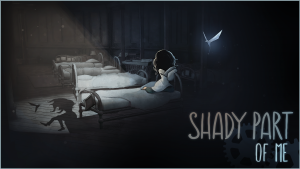Review for Shady Part of Me

Carl Jung theorized that the shadow self, the unconscious self – or at least an aspect of one’s personality that the conscious self isn’t aware of – represents the parts of a person that they don’t want to acknowledge, for one reason or another. Everybody has one, however, and there’s nothing inherently “bad” or negative about it; in fact, accepting one’s shadow self can lead to a more balanced life. With their puzzle-platformer Shady Part of Me, developer Douze Dixièmes has interpreted this abstract idea in a very literal sense, telling the story of one little girl and her shadow, acting independently but working together to avoid danger, solve puzzles, and escape the institution in which they have been locked away. Though the game’s overall narrative suffers from something of a split personality, hinting at a deep story but being far too cryptic about it, the myriad bite-sized puzzles are fantastically imaginative and there is plenty of endearing characterization, ultimately satisfying one of the two parts of my adventure-gamer-self more than the other.
Even at her young age, the game’s half-pint heroine seemingly carries the world on her shoulders, suffering from all manner of anxieties. She is a perpetual outcast, convinced that the world laughs at her and wishes her ill. She also has a debilitating fear of light and will freeze up and curl in on herself if struck by it during gameplay. Instead, she prefers to stay enveloped in a safe blanket of shadow and darkness, forcing you to go to great lengths to ensure that she is concealed at all times.
The flipside of this coin is her shadow self, a silhouetted twin who suddenly and inexplicably becomes sentient. Having just gained existence, she knows nothing of the world or of her counterpart’s fears and anxieties; instead, she is pure drive, pushing forward towards an exit simply because she knows nothing else. While the physical little girl shuns brightness, her shadow can only exist when bathed in light. Should the light source around her extinguish or be momentarily blocked out, she ceases to exist. Thus, both protagonists have clear limitations put upon them that the player must heed in order to proceed.
The two girls, while joined by some psychological bond, act and think independently, and even freely converse with each other as strangers meeting for the first time, just getting to know one another. In between, the game’s five acts feature over a hundred small-scale puzzles, each with the aim of finding a way to get both characters safely from point A to point B, then doing it all over again as the next stage of the level becomes available. Control can be easily toggled between the two characters at any time, with the inactive partner staying put until activated again.
Generally the girls must clear a path to proceed from left to right, with only the occasional section involving more three-dimensional or vertical travel. The shadow girl, who’s always tethered to her two-dimensional plane, is the only one with the ability to jump in order to platform across environmental hazards, like spiky floors and falling blocks. This works well, either via keyboard or gamepad input, allowing for a good amount of precision but not requiring overly deft reflexes. Other than that, both protagonists are able to run, climb onto low obstacles, and interact with the puzzley bits in the environment.
Even though the two heroines don’t really know each other and they see eye to eye less and less as the game progresses, the imaginative puzzle designs force them to constantly cooperate. It’s rare that one of them can reach the end of a puzzle without assistance from the other, generally in the form of pulling levers that trigger something in the other’s world, pushing blocks onto weighted switches, activating floating platforms, or adjusting light sources. Even depth becomes important, as moving an object further away from a light source in the physical world causes its shadow to shrink, potentially making it low enough to become reachable. Those who like extra challenge can even go after some collectibles, in the form of origami birds flapping away in both the real world and shadow realm.
There are no formal enemies to battle against (though there is a “boss” encounter revolving around some light platforming), but if either girl becomes debilitated and can’t continue, a rewind mechanic can be enabled at the push of a button. This is a very forgiving feature, accessible at all times (making it useful for puzzle solving as well) without usage limitations or a recharge timer. At any point, you can freely undo the last few seconds, go all the way back to the beginning of the stage, or stop anywhere in between.
The puzzles are definitely one of the high points of Shady Part of Me, and even though the theme is always about light and shadow, there is plenty of variety in the execution and lots of lovely moments strewn throughout the four- to five-hour campaign. Whether sending players through a dank sewer system or visiting the grounds of a traveling circus, the designers’ imagination has been limited only by the creative lengths a little girl must be willing to go to cope with her harsh reality.
Although the tangible young protagonist is bound to the basic laws of physics, her shadow self only needs to adhere to her own two-dimensional plane of movement, leading to certain puzzles where the latter can move vertically or even end up upside down. For example, if the terrain causes the shadow girl’s plane to tilt ninety degrees, she’ll end up facing and moving vertically until another, opposing right-angle axis shift causes her to end up right-side up again.
The only downside is that nothing ever leads to big narrative payoffs, even though everything in the unfolding plot and the characters’ interactions with each other suggest it eventually will. The exchanges between the girls, the therapy sessions (which we hear excerpts from but never see with our own eyes), the backstory behind certain locations, implied to be critically important but never explained – it all really needs to be tied together more cohesively to make everything gel smoother. There’s a vital difference between going through the puzzle-solving motions for their own sake and being properly rewarded by the story all your mental efforts were meant to reveal. Not every game needs an accessible narrative wrapped up neatly in a bow, but when something stronger and deeper is hinted at so aggressively, the lack of payoff becomes a big deal and keeps the game from becoming greater than just the sum of its parts.
Fortunately, one such part that truly shines is the game’s presentation. Environments – both the real-world 3D locales as well as the shadow realm’s flat 2D planes – have a gorgeous hand-painted watercolor look, though the palette is heavily limited to dark earth tones like ochres, tans, and grays, presumably reflecting the little girl’s gloomy state of mind, while features of the real world can be depicted as far more exaggerated and threatening than they ever really were. As both girls move through the levels, literal words – thoughts, messages, streams of consciousness – become visible in the environment, doing as much storytelling as the voice-overs, though also with the same lack of clarity.
The two protagonists have unique voice actors, with the physical girl’s high-pitched voice lending her a palpable air of vulnerability, while her shadow version is the more down-to-earth, level-headed voice of reason. The score, mostly understated and atmospheric, is made up of incredibly relaxing and mood-setting piano pieces, sometimes accompanied by lilting vocal tones. It makes for a wonderful background accompaniment that underscores the mental gymnastics you’ll need to perform.
Shady Part of Me will surely appeal to those who want an atmospheric puzzle experience that isn’t afraid to embrace its more surreal side. The gameplay doesn’t disappoint, continually offering something new and hitting that sweet spot between challenging and accommodating, particularly with the rewind mechanic that relieves the stress of permanent threat. The story, however, feels more hinted at than overtly delivered, and lacks the memorable and decisive narrative moments that would help it stick the landing. In this department the game falls far too flat, so connoisseurs of deep, involving plots should be forewarned, but all others who value engaging gameplay will surely find plenty that’s worth their time here.






























